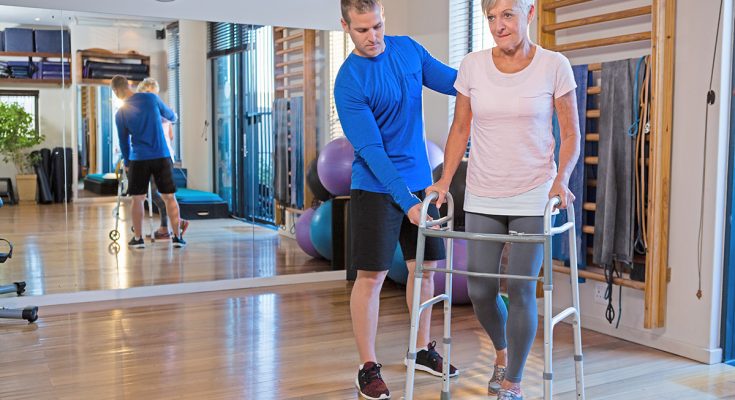Spinal fusion surgery is a significant step toward stability and pain relief for many patients. But recovery doesn’t stop at the incision. Real progress comes through guided rehabilitation that helps individuals regain strength, mobility, and confidence. Dr. Larry Davidson, a leader in minimally invasive spine surgery, recognizes that physical therapy milestones are not just markers of healing after fusion. They form the foundation for long-term success and sustained recovery. For patients considering or preparing for spinal fusion, understanding the typical benchmarks along the recovery journey can ease anxiety and set realistic expectations.
Every recovery is unique, shaped by the patient’s age, overall health, type of fusion and activity level before surgery. While milestones offer helpful guidance, they are not rigid deadlines. The timeline may speed up or slow down depending on how the body responds to healing and therapy. The important focus is steady progress under the supervision of a professional team that adjusts the plan as needed.
Week 1 – From Bed to Basic Mobility
The first days after spinal fusion are focused on protection and safe, gentle movement. Patients typically begin therapy in the hospital or at home under close supervision. The primary milestones during this period include:
- Sitting up in bed with proper spinal alignment
- Standing with assistance, using safe techniques
- Walking short distances with a walker or support
- Learning logrolling to get in and out of bed
Therapists emphasize protecting the surgical site, while preventing complications such as blood clots or lung issues. Breathing exercises, ankle pumps and brief standing sessions are part of daily routines.
Weeks 2-4 – Building Early Independence
As initial pain and swelling subside, physical therapy focuses on restoring functional independence while respecting spinal precautions. Key benchmarks during this phase include:
- Walking greater distances without excessive fatigue
- Transitioning from a walker to a cane or no assistive device
- Sitting comfortably in a chair with proper posture for longer periods
- Performing light daily activities (such as dressing or preparing simple meals)
Therapists introduce gentle movements that support spinal alignment and encourage circulation. Education on posture, pacing and safe body mechanics continues, helping patients avoid re-injury as they move more.
Weeks 4-8 – Restoring Strength and Endurance
With healing well underway, patients enter a more active phase of rehabilitation. The focus shifts toward rebuilding strength in the core, hips and legs to support the fused segments. Typical milestones during this phase include:
- Walking moderate distances on varied surfaces
- Climbing a few stairs safely
- Engaging in light home exercises for strength and flexibility
- Practicing posture correction and controlled movement
Dr. Larry Davidson points out that this is a critical stage for setting up long-term success. Patients who stay consistent with therapy during this window tend to achieve smoother recoveries and avoid compensation patterns that can cause future strain.
Weeks 8-12 – Advancing Functional Movements
As the fusion stabilizes, patients work toward more dynamic tasks. Therapy introduces targeted exercises that prepare the body for real-life demands, while monitoring form and endurance. Milestones during this stage often include:
- Walking longer distances without assistive devices
- Performing bodyweight exercises like gentle squats or bridges
- Improving balance and coordination
- Lifting light objects with proper mechanics
Therapists guide progression carefully, balancing challenges with the protection of the spine. This phase often brings visible gains in confidence and mobility.
3-6 Months – Returning to Normal Activities
By this point, many patients are ready to resume routine tasks with greater independence. Milestones during this stage include:
- Driving (with surgeon clearance)
- Returning to light work duties
- Participating in low-impact recreational activities
- Carrying moderate loads safely
Strength and flexibility continue to improve, and therapists may begin introducing more advanced exercises based on individual goals. Some patients begin preparing for sport-specific activities or physically demanding occupations.
Beyond 6 Months – Advanced Conditioning
Recovery after spinal fusion continues well beyond the initial six months. For those aiming to return to higher levels of activity, therapy develops to include:
- Core and hip strengthening under load
- Advanced balance and agility drills
- Return-to-sport or labor-specific conditioning
- Ongoing education on spinal health maintenance
During this period, patients may graduate from formal therapy and transition to independent exercise programs that support lifelong spine care.
Common Challenges Along the Way
While milestones provide a roadmap, recovery is not always a straight line. Challenges that may arise include:
- Fatigue during early walking phases
- Stiffness in surrounding joints
- Emotional ups and downs as progress plateaus or advances unevenly
- Fear of movement or re-injury
Physical therapists help navigate these challenges by adjusting plans, offering reassurance and reinforcing safe techniques that build resilience.
The Role of Ongoing Support
Successful spinal fusion recovery is a team effort. Surgeons, therapists and patients must communicate clearly about progress, concerns and goals to create a unified path forward. Therapists provide essential feedback to the surgical team about healing patterns, functional gains and any emerging issues that may require adjustments to the care plan.
This collaboration allows for early identification of challenges, such as limited mobility, pain flare-ups or signs of hardware complications, ensuring that interventions can be implemented promptly. It also empowers patients to take an active role in their recovery, building confidence and accountability as they work toward their rehabilitation targets. This collaborative approach helps ensure that patients not only meet milestones but also sustain them and build a solid foundation for long-term health and quality of life.
Patience, Consistency, and Long-Term Success
Spinal fusion recovery takes time. Each phase builds on the last, and every milestone achieved represents meaningful progress toward lasting, durable results. Patience and persistence are key, as healing is a gradual process that requires dedication at every stage.
Patients who remain consistent with therapy, follow precautions and embrace steady progress are more likely to regain fuller function, improve mobility and avoid common setbacks such as re-injury or delayed healing. The support of a skilled care team can make a significant difference, offering encouragement, adjusting plans as needed and ensuring that recovery stays on track.
With proper guidance, spinal fusion can mark the start of a stronger, more confident future. A new chapter focused on resilience, independence and improved quality of life, rather than simply the end of a surgical journey.




